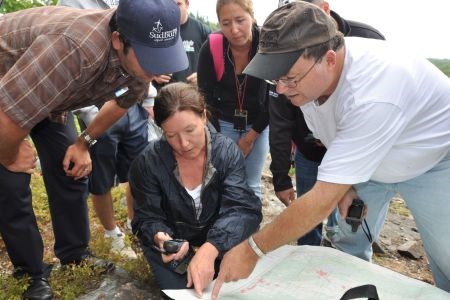As one of only two accredited mining engineering technology programs offered in Canada, Cambrian College's course of study offers students a unique opportunity to prepare for the workplace, meeting the expectations of potential employers.
The Sudbury school, whose program was first accredited by the Canadian Technology Accreditation Board in 2004, recently renewed its accreditation until 2014. Having the designation creates a benchmark to ensure the college is teaching mining fundamentals recognized by industry, Tim Jones, a Cambrian mining engineering technology professor, explained.
“From our perspective as teachers, it's a useful second setting of what we give to the students,” he said. “It helps us to identify and make sure that we're covering all the areas necessary for the students to have when they graduate and enter into the workplace.”
Mike Mayhew, director of global business services with Stantec's mining division, serves as chair of Cambrian's Mining Program Advisory Committee. Comprised of representatives from industry players such as Stantec, Xstrata Nickel, Vale and Quadra FNX, the committee is designed to provide insight into programming in an effort to continually enhance the college's offerings.
Mayhew said the school's courses are beneficial, because it gives students a strong background
in mining fundamentals, from surveying, rock mechanics and mining methods to AutoCAD, report writing and English.
“There's a variety of courses there that are basically tailored to the industry, and Cambrian College and the advisory panel are always leaning on industry to make sure that they stay on the latest technology and what industry is really looking for,” he said.
A high-calibre education is even more essential at a time when few mining engineering technology programs exist and even fewer students are entering the programs that are offered, even though “the opportunities, as far as I can tell, from a 30-year perspective, are almost open-ended at this point,” Jones said.
“There isn't much in the way of mining education across Canada; the numbers are really thin on the ground,” he said. “The number of programs and the number of students taking them are way low relative to the needs of industry for any kind of engineering technician, technology or degree.”
His industry contacts say mining engineering technologists can command high salaries because of the shortage, but existing staff are burning out because there are fewer people to share the workload.
Contributing factors to low enrolment include the cyclical nature of mining and skepticism about job stability, incurred because of past labour disputes. It's frustrating, Jones said, because he sees graduates landing good jobs, particularly out of the province and especially in Western Canada where there is a huge demand for skilled workers and where a graduate of an accredited program like Cambrian's will do well.
A trend amongst this year's crop of students is to leave school for work after two years, rather than staying to complete the full three-year course, which has resulted in a dearth of third-year students. This, despite industry advisors saying they prefer three-year grads, who are more versatile, will advance faster, and earn better pay, Jones said.
“It's pretty hard if you're coming out of second year and you're faced with a choice between spending more money and not earning anything, or going out and working right away and making what, at that point, looks like good money,” he said.
Mayhew believes the industry itself has to make a stronger effort to promote mining and spark interest amongst upcoming students, starting with youth in elementary school, to avoid perpetuating misconceptions about the industry.
“Mining is not just a pick and a shovel when you're going underground,” he said. “There are a lot of venues and opportunities you can get into.”
Most people are not well educated about the industry, so they see 'mining' as a dirty word, he said. But companies like Stantec have made an effort to bring more students into the fold, welcoming them into the office to offer advice on how to guide their careers and get them prepared for what the industry's about.
Cambrian, meanwhile, hosts field trips and events like Mining Day, providing networking opportunities for students to connect with mining industry representatives.
“We want to hire the best students with the right attitude,” Mayhew said. “Having the right people with the right attitude and education is great, but in the end it's the people that want to go above and beyond that we want to continue to bring into our industry and continue to promote.”




